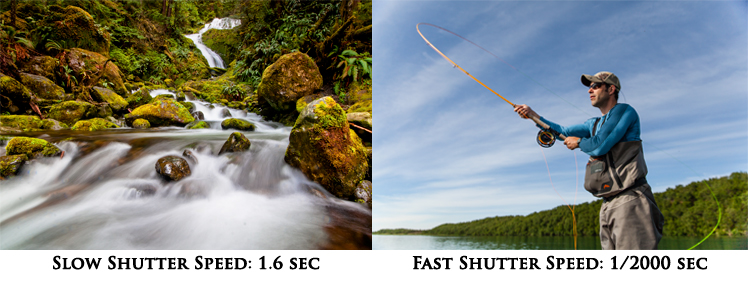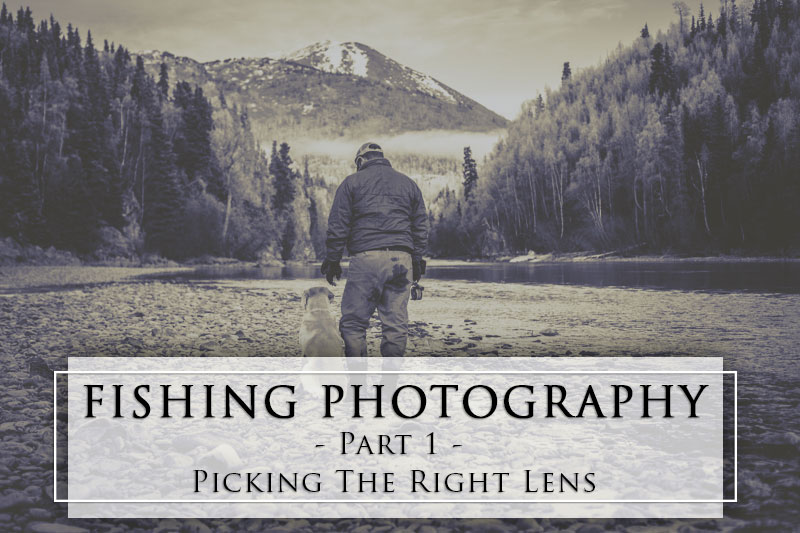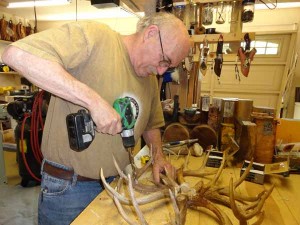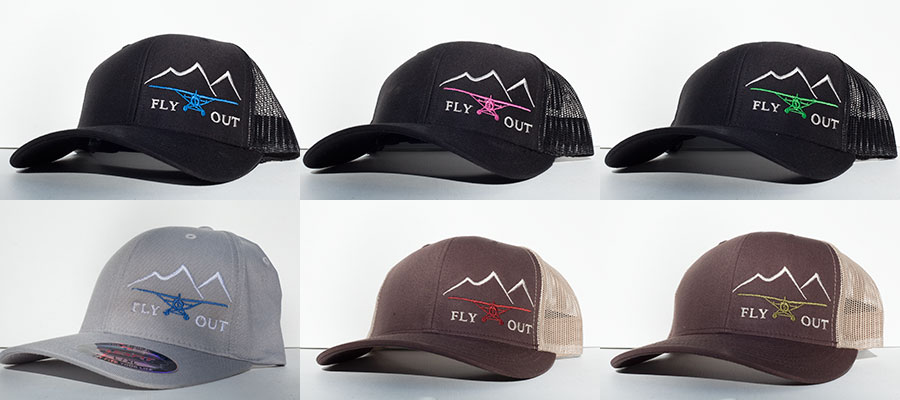Part 2 of 3
No video selected.

I think taking on full manual control of a camera is a goal for any aspiring photographer looking to improve their skills. While it is very intimidating at first, learning manual control can be taken one step at a time through the use and understanding of the camera’s preset priority modes. In the last “Behind the Lens” article we discussed choosing the proper lens for your fishing photography. Building on that, I will briefly discuss using priority modes in preparation for takingon full manual control of your cameras settings.
Shutter Priority -
Outside of full manual control, using your cameras shutter priority mode (“S” on Canon or “Tv” on Nikon) is the best way to learn how to control the amount of movement and/or blur produced in your final image. Here, your camera allows you to choose the desired shutter speed, while it takes control of the remaining ISO and aperture settings. When trying to capture fly line in flight, or a fish doing mid-air cartwheels, you will find that cranking up the shutter to the maximum possible speed is necessary to get a sharp, clean image. While this is not exactly rocket science, it is necessary to understand completely. I can hold my camera steady at a shutter speed of 1/60th or faster by hand, but if I need to shoot any slower, a camera support is necessary to avoid blur in the final image.
The downside to using the shutter priority mode lies in the photographers inability to set the desired depth of field. Keeping this limiting factor in mind, I always enjoyed experimenting with the shutter speeds when trying to capture a fly line in flight. I would start at a low shutter speed, and continuously analyze how “frozen” the line and angler were as the speed was ramped up. Over time I realized that sometimes a little blur is a good thing, giving the image a sense of movement and action that a completely still frame does not have.

on Tuesday, 20 January 2015.
Posted in Photo, Article, Gear
Part 1 of 3
No video selected.

Recently, I have had a few people ask me about lens selection in regard to fishing photography. More precisely, "What is the best lens I can get for the majority of my fishing situations?" While I wish it were a simpler question to answer, the fact is, each lens type has its own pros and cons. Every individual lens captures emotions differently, almost as if they have their own unique "personality." Here's my rundown:
Wide-Angle - The Hank Patterson of Lenses

I think we all have that fishing buddy who always brings the party. They always bring the beer, and are fun as hell regardless of the fishing conditions. They often get worked up over every fish, and are relentless in hassling you after you farm a monster. Simply put, a wide-angle lens is more or less the "Hank Patterson" of camera gear.
I find that images taken with a wide-angle lens have their own special kind of excitement to them. This lens style has a tendency to separate a subject from its background by maximizing the foreground and minimizing the size of the background. This will in turn add a lot of depth to your imagery. I find I most commonly use my wide-angle lens for grip and grin, close up action, and just all around energetic fishing situations.
While this style lens has provided me with a lot of great images, it also comes with it's own set of disadvantages. Unless you are shooting landscape images, where you are trying to shoot an entire scene, capturing your subject full frame requires the camera to be tight to the subject. Mountain ranges, trees, and other parts of your background tend to shrink in comparison to your subject. So if you are looking at capturing the details of the background, you may need to go with a longer style lens. When used properly though, a wide-angle lens can be one of your favorites, and is a must have in any photographers arsenal.
My personal favorite is the Cannon 20mm F/2.8 Ultrawide. It provides crisp, energetic images with minimal distortion, and won't completely break your bank at about $539.
on Tuesday, 13 January 2015.
Posted in Photo, Article, Gear
From Bolduc Knives
No video selected.

We asked specialty knife maker, Gary Bolduc, to design and manufacture a special edition Fly Out knife that is extremely tough and multi-functional, and engraved with our signature bush plane logo. It is a fantastic utility, hunting, backpacking, and all purpose knife that is a tough little monster! It has a stone wash finish 3.5" blade, para cord wrap 4" handle built out of S35VN stainless steel with a kydex sheath. The knife is super slim, yet tough as nails, extremely light weight, with 2 lanyard holes for pole lashing or handle pull & spine gimping for finger control. Holes in kydex sheath allow you to tie it anywhere you want or use the belt loop to carry.
Bolduc Knives is synonymous with quality when it comes to the knife industry for sportsmen. Many of his hunting and fishing knives are inspired by Alaska, and we're proud to have one of his products bear the Fly Out brand. You can purchase a Fly Out knife by emailing us at [email protected]. These knives start at $150 + shipping. Different knife handles are available upon request.
 About Gary:
About Gary:
Raised as a young man in Vermont attracted my interest to the views of the rolling hills, country back roads and flowing streams. Around eight or nine years of age, I started exploring the geography within a 2 or 3 mile radius of my home in the countryside. I would collect stones, odd pieces of wood, or whatever I thought was interesting. I always wondered what was over the next hill, usually climbing a tree for a better vision if I dared not to venture any further. As I grew older, I lost this fear and traveled as far as I could in one day, of course, coming home exhausted. Once I turned sixteen and obtained a driver's license, I was allowed to explore vast areas via back country roads. I would stop at interesting streams, apple orchards gone wild and maple tree stands of forest for a new exploration, all of the time watching for deer, woodchucks, partridge, hawks, squirrels and whatever else I would happen upon or would cross my path.
Read More about Gary Bolduc
on Monday, 04 November 2013.
Posted in Article, Gear
$25 plus Shipping
No video selected.

We finally have some Fly Out hats in stock with some new colors and designs. We have truckers and 1 flex fit style (see photos above). They are $25.00 + shipping.
If you would like to order a hat, send an email to [email protected] that includes the following:
• Your Name
• Mailing Address
• Hat Style and Color Options + Quantity
We will send the hat(s) to the address and follow up with an electronic invoice via PayPal that can be paid by debit/credit.
We will have an online shop location soon for a wide variety of Fly Out apparel/gear soon (hoodies, t-shirts, knives, buffs, hats, etc.).
More soon!
on Tuesday, 10 September 2013.
Posted in News, Gear
Just In Time for the Holidays!
No video selected.
 These limited edition hats were floating around Alaska last summer with our guide ambassadors. Now you can purchase one yourself for $25 + shipping. We've embroidered these hats on high quality flexfit (Yuupong) and trucker (Richardson) hats. We will ship anywhere in the U.S. Email us today to order at [email protected].
These limited edition hats were floating around Alaska last summer with our guide ambassadors. Now you can purchase one yourself for $25 + shipping. We've embroidered these hats on high quality flexfit (Yuupong) and trucker (Richardson) hats. We will ship anywhere in the U.S. Email us today to order at [email protected].
{gallery}/BlogContent/Dec2012/gallery{/gallery}
on Tuesday, 11 December 2012.
Posted in Gear
A Special Deal That Helps Our Wilderness

Sportsman's Alliance for Alaska has teamed up with Pro Guide Direct, IBEX and Mountain Khakis to provide you a special deal that also helps our wilderness.
Simply click the image above and make a purchase between November 17 and December 3 to take advantage of the special promotions. On top of a terrific deal, 15% of your purchase will benefit SAA's work to protect Alaska's incredible public lands for fishing and hunting.
You can visit the Sportsman's Alliance for Alaska at the following link:
http://www.sportsmansalliance4ak.org/
on Monday, 28 November 2011.
Posted in Conservation, Gear





 About Gary:
About Gary:
 T
T